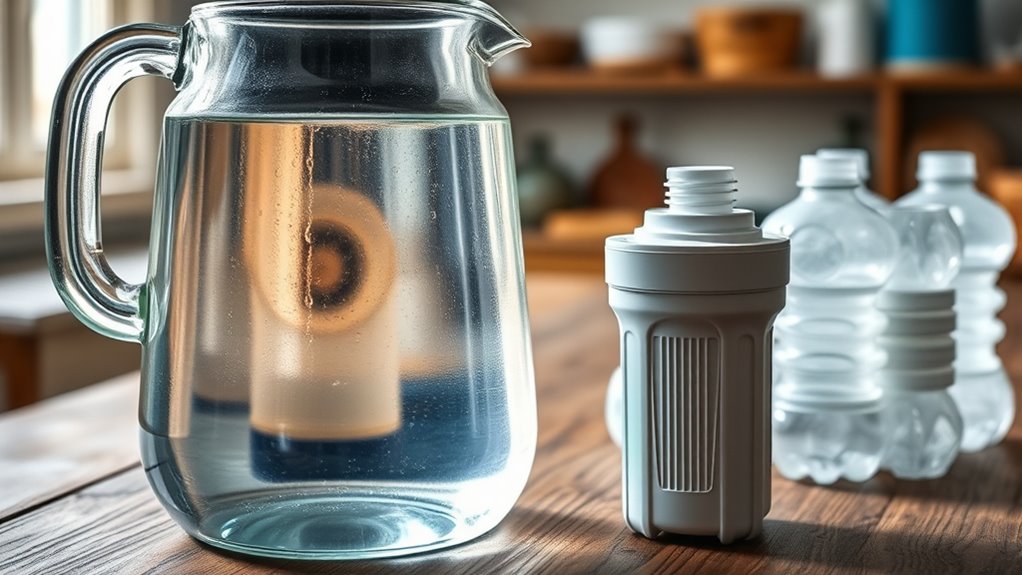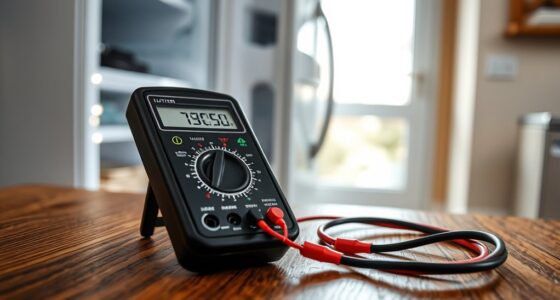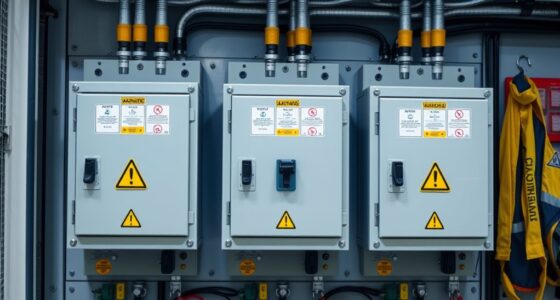To keep drinking water safe during long outages, stock up on bottled water and rotate supplies regularly. If using tap water, boil it for at least one minute or use a proper filtration system to remove contaminants. Store water in clean, sealed containers away from sunlight and chemicals, and test well water frequently if you rely on a private source. Proper handling and maintenance are key—continue along to learn how to guarantee your water stays safe and available.
Key Takeaways
- Stock sufficient bottled water and rotate supplies every 6 months to ensure freshness and safety.
- Use properly sealed, food-grade containers for storing water, and keep them in cool, dark places.
- Flush all taps and water lines thoroughly after power restoration before using tap water.
- Test stored and tap water for bacteria, lead, nitrates, and other contaminants before consumption.
- Maintain well seals, prevent flooding, and regularly inspect private water sources to prevent contamination during outages.
Immediate Use of Safe Drinking Water Sources

During water outages, the quickest way to guarantee safe drinking water is to use bottled water that hasn’t been exposed to flood or contamination. Keep a supply of commercially bottled water stored in advance for emergencies. This water needs no treatment or boiling, so it provides instant safe drinking, cooking, and hygiene options. Use bottled water preferentially to avoid risks from contaminated sources. Remember to replace or rotate your stock regularly to prevent expiration or quality loss. If bottled water isn’t available, treat tap water with household bleach—eight drops per gallon—and let it stand for 30 minutes. If the water looks cloudy, filter or settle it first. Proper storage of emergency water supplies is essential to maintain their safety and effectiveness during long outages. Ensuring your water storage is made from durable materials helps prevent contamination over time. Additionally, understanding water treatment techniques can help you effectively purify water from less reliable sources when necessary. Maintaining awareness of sustainable materials used in water containers can also contribute to safer storage practices.
Boiling Water for Safety and Effectiveness

Boiling water is a simple and effective way to kill most disease-causing microorganisms, making it safer to drink during emergencies. When you bring water to a rolling boil, you damage bacteria, viruses, and protozoa by disrupting their proteins and cell membranes. Studies show boiling reduces microbial contamination by 86–99%. For water below 1,000 meters altitude, boil for at least 1 minute; above 5,000 feet, boil for 3 minutes due to lower boiling points. Pre-filter cloudy water through a clean cloth before boiling to remove particles that shield microbes. After boiling, let it cool naturally and store it in clean, covered containers to prevent recontamination. Using electric kettles can improve efficiency and reduce handling risks, ensuring your water remains safe. Boiling water is the most effective method to eliminate these pathogens and is recommended by health authorities worldwide. Additionally, understanding the optimal boiling times can ensure maximum safety without wasting resources. Properly storing boiled water in clean containers can also prevent recontamination and keep it safe for longer periods. Ensuring your water is free of contaminants is essential, and treating water with boiling is a reliable method to do so. Regularly inspecting your water sources can help you identify potential contamination risks before boiling.
Utilizing Water Filtration and Treatment Systems
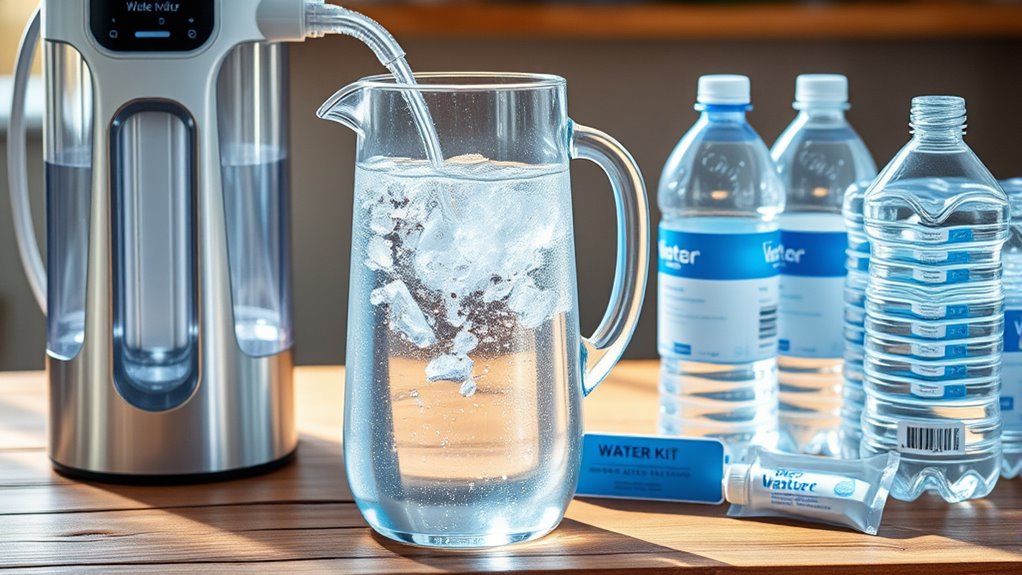
Utilizing water filtration and treatment systems is an effective way to guarantee safe drinking water during emergencies, especially when electricity or chemicals aren’t available. Portable systems like the Outback filter can produce up to 24 gallons daily, removing bacteria, protozoa, viruses, and other contaminants, meeting EPA standards. They’re compact, durable, and easy to deploy, requiring no tools or power. Gravity-fed filters are ideal for home or camp use, passing water through multi-stage processes that eliminate biological and chemical pollutants. Regular maintenance, including timely cartridge replacements, ensures consistent performance. Combining filtration methods, such as ceramic and activated carbon, broadens contaminant removal. Proper sanitation and maintenance are crucial to prevent recontamination and ensure ongoing water safety. Confidence in emergency water provision ensures the removal of 99.9999% bacteria, viruses, and cysts, and stocking replacement filters ahead of time guarantees continuous access. Understanding water treatment technology can help you choose the most effective system for your needs. These systems offer a cost-effective, reliable solution to keep your water safe during extended outages and are an essential component of emergency preparedness for any situation.
Precautions for Private Well Water Safety
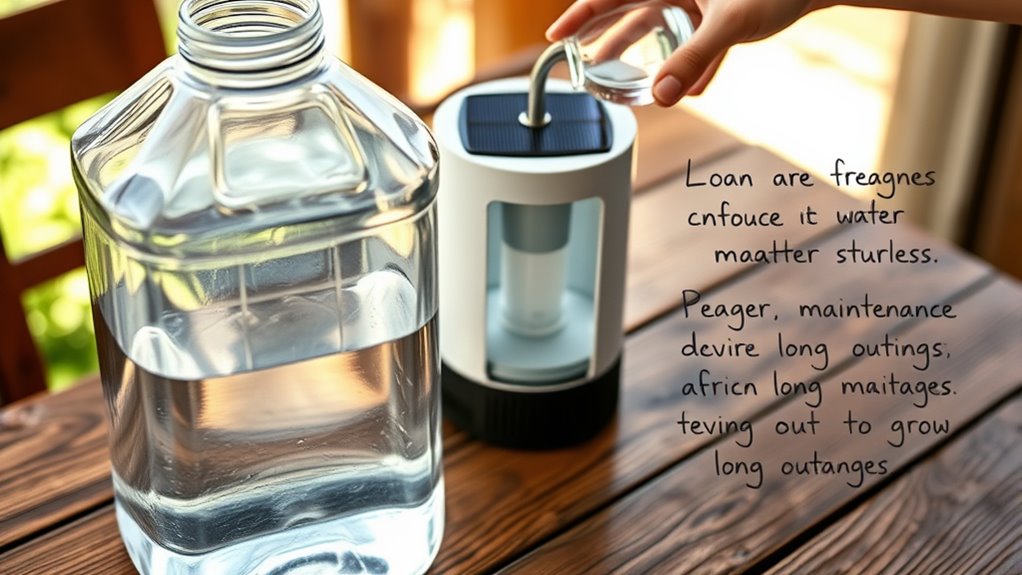
Protecting your well from flooding and contamination is vital, especially during storms or heavy rainfall. Regularly testing your water quality helps catch issues early and keeps your supply safe. Proper well maintenance ensures your system stays reliable and reduces the risk of harmful contaminants entering your water. Ensuring proper well sealing and casing integrity is also essential to prevent surface contaminants from entering the well during severe weather events. Additionally, understanding the importance of flood prevention measures can help safeguard your water supply during extreme weather conditions. Implementing emergency preparedness plans that include backup water sources can provide peace of mind during prolonged outages. Maintaining these precautions supports the overall well water safety and helps ensure your drinking water remains clean and healthy during long outages. Regular inspections and adherence to recommended guidelines are key to protecting water quality.
Well Flood and Contamination Risks
Floodwaters pose a significant threat to private well water safety because they can carry harmful bacteria, viruses, parasites, and chemicals that contaminate well supplies. If floodwaters rise above the well casing or seep through unsealed spaces, contaminants can enter through damaged caps, casings, or underground migration from nearby flooded wells or excavations. Shallow wells, wells in pits or basements, and those near flood-prone areas are especially vulnerable. Surface runoff, even without direct flooding, can introduce pollutants into your well, making proper well construction practices crucial for prevention. Flood impacts often change water taste, color, and sediment levels, signaling possible contamination. To protect your well, store emergency water, disconnect power during floods, and install watertight caps. Properly sealing and elevating your well can drastically reduce contamination risks during future floods. Ensuring your well is properly maintained and protected is essential for thriving plants and pest-free gardens, even during emergencies. Additionally, regular inspections and maintenance of well seals and casings help prevent contamination from underground migration, especially in flood-prone regions. Implementing proper well construction practices can further minimize the risk of contamination during flood events. Regular testing of well water after floods is vital to confirm safety before use.
Testing Water Quality Properly
Ensuring your private well water is safe begins with proper testing procedures. First, choose a reputable, certified laboratory, preferably one accredited by NELAP and using EPA-approved methods. Verify their credentials through local health agencies and consider cost and convenience. Many accredited labs provide sampling kits and instructions to prevent contamination during collection. When collecting samples, use approved containers, and guarantee the well and surrounding area are clean. Draw water directly from a dedicated tap or sampling port, avoiding household faucets. Transport samples within 24-48 hours, keeping them cool. Regular testing should include bacteria, pH, nitrates, and other contaminants relevant to your area. Proper testing helps detect issues early, guiding you to take necessary corrective actions to keep your water safe. Additionally, understanding the effectiveness of filtration technologies can help you select appropriate treatment methods if contamination is detected. Implementing proper sample handling techniques is essential to ensure the accuracy of test results and reliable assessment of water safety.
Well System Maintenance Tips
Maintaining your private well system is essential for keeping your water safe and clean. Start by ensuring the well has a secure, tight-fitting sanitary cap to prevent surface contaminants. Fully seal the space between the casing and borehole, and keep the site graded to direct water away from the wellhead. Maintain a minimum 100-foot buffer zone around the well to avoid chemical or waste contamination. Regularly inspect the casing and cap for cracks, damage, or corrosion, and check that seals around electrical connections are intact. Monitor your well pump for signs of inefficiency, like low pressure, strange noises, or high electricity bills. Schedule routine maintenance, including testing pressure tanks, inspecting switches, and cleaning the system. Conduct annual inspections and keep detailed records to ensure ongoing safety and compliance.
Proper Water Storage and Emergency Preparedness
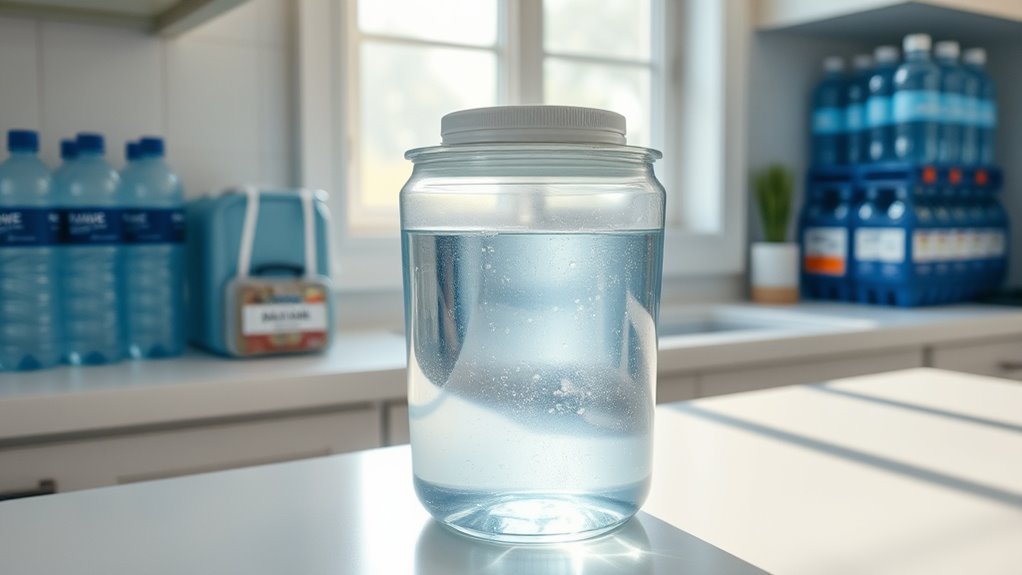
You need to store water in clean, food-grade containers to keep it safe and prevent contamination. Make sure to rotate your supplies every six months to guarantee freshness and effectiveness. Proper storage and regular replacement are key to maintaining a reliable emergency water supply.
Store in Clean Containers
Using clean, food-grade containers is essential for safe water storage, especially during emergencies. Select containers made of plastic, steel, or FDA-approved materials designed for water. Make certain they have tight-sealing lids or permanent covers with small capped openings to prevent contamination and evaporation. Avoid glass, containers that held toxic chemicals, or porous cartons like milk or juice boxes. Before filling, wash containers thoroughly with soap and water, then sanitize with a bleach solution—1 teaspoon of unscented bleach per quart of water—shaking to contact all surfaces. Rinse or air dry before use. Store water in cool, dry places away from sunlight and chemicals. Properly cleaned and sealed containers help maintain water quality and safety during long outages.
Regularly Rotate Supplies
Regularly checking and rotating your stored water helps guarantee it remains safe to use over time. You should inspect your supplies every 6 to 12 months for signs of contamination, such as cloudiness, foul smells, or mold. Rotate water at least once a year unless you’ve added preservatives like chlorine bleach, which can extend its shelf life. Store-bought water should be replaced based on expiration dates due to container degradation. Use opaque containers in a cool, dark place to hinder microbial growth. Label each container with the fill date and follow a first-in, first-out system to keep supplies fresh. Keeping records of rotations ensures timely replacements. Proper rotation minimizes risks and ensures your water remains safe for drinking or other uses during emergencies.
Additional Tips for Handling Water During Outages

During water outages, handling your water supply carefully is crucial to prevent contamination and guarantee safety. To do this effectively:
- Flush all cold water taps for about five minutes after power returns to clear any contaminants.
- Replace filters in refrigerators and filtration systems, and clean ice maker lines—discard existing ice.
- Test your water for contaminants like bacteria, arsenic, lead, nitrate, and uranium if baseline data isn’t available or after an outage.
- Store enough bottled water for at least three days, and avoid using tap water until it’s been properly flushed and tested.
These steps help ensure your water remains safe to use, reducing health risks during prolonged outages. Proper handling protects you and your family from potential waterborne hazards.
Frequently Asked Questions
How Long Can Stored Water Remain Safe to Drink?
You can keep stored water safe for up to six months if it’s properly disinfected, stored in a cool, dark place, and kept in airtight containers. For longer storage, regularly replace it every 6 to 12 months to maintain freshness, taste, and safety. Remember to label your containers with the date and verify they’re sealed tightly, avoiding contamination and degradation over time.
What Are the Signs of Contaminated Well Water After an Outage?
You might notice your well water looks cloudy, murky, or has visible sediment, indicating contamination. Discolored water, like brown, reddish, or greenish hues, suggests minerals or algae. A metallic or chemical taste, or a rotten egg smell, points to bacterial or chemical issues. If you see oily films or stains, or experience symptoms like stomach upset or headaches, contaminated water could be affecting your health. Always test and disinfect after outages.
Can I Use Household Bleach to Disinfect Water?
Yes, you can use household bleach to disinfect water. Use regular, unscented bleach with 5-9% sodium hypochlorite, and add about 8 drops per gallon of clear water, doubling for cloudy water. Stir well and wait at least 30 minutes for disinfection. verify proper handling by wearing gloves, avoiding mixing chemicals, and using a clean dropper. Recheck for a faint chlorine smell before drinking.
How Often Should I Test Private Well Water for Safety?
You should test your private well water at least once a year to guarantee it’s safe. Additionally, test more frequently after well repairs, flooding, or changes in water quality like taste or odor. If vulnerable people live with you, or if local health advisories recommend, increase testing. Regular testing helps catch emerging problems early, keeping your water safe and your family protected. Use a certified lab for accurate results.
What Storage Containers Are Best for Long-Term Water Preservation?
When it comes to long-term water storage, you want containers that are up to the task and not a flash in the pan. Opt for food-grade, BPA-free plastic with tight-fitting lids, UV-resistant or opaque to prevent bacterial growth. 5-gallon containers with spouts are portable and easy to handle, making them ideal. Regularly inspect and keep them in a cool, dark place for maximum freshness and safety.
Conclusion
By staying vigilant and following simple steps, you can safeguard your supply and stay safe. Boil, filter, and store water wisely, always prioritizing purity and preparedness. Keep your containers clean, check for contaminants, and remain mindful of your well’s condition. With a little planning and proactive precautions, you’ll weather water worries and ward off worries, ensuring your well-being during any long outage. Stay smart, stay safe, and secure your sip!

